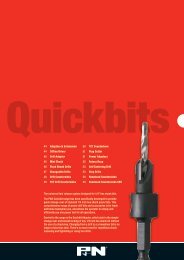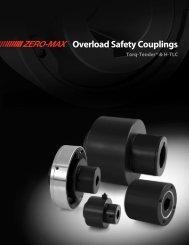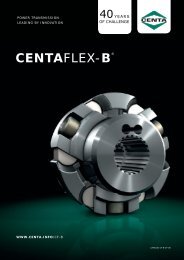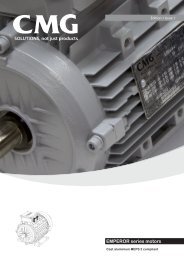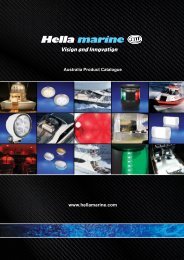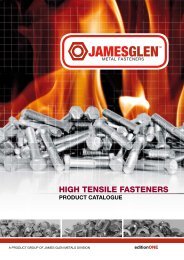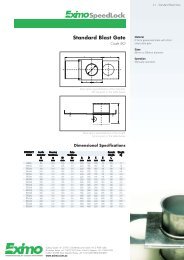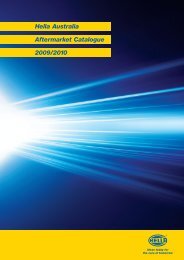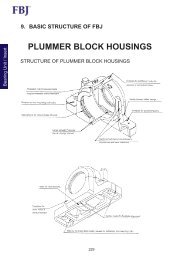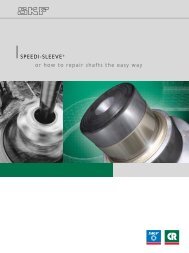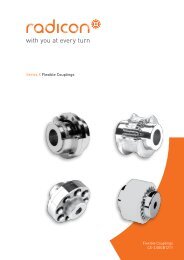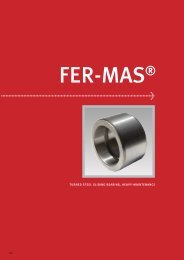Renold Couplings Cat 7th-4 - Industrial and Bearing Supplies
Renold Couplings Cat 7th-4 - Industrial and Bearing Supplies
Renold Couplings Cat 7th-4 - Industrial and Bearing Supplies
Create successful ePaper yourself
Turn your PDF publications into a flip-book with our unique Google optimized e-Paper software.
Flexible <strong>Couplings</strong> should be used to accommodate any combination of<br />
misalignment conditions described below.<br />
At installation all couplings should be aligned as near to perfect<br />
as possible.<br />
1. Angular<br />
Angular misalignment is present when the shaft axes are inclined<br />
one to the other. Its magnitude can be measured at the coupling<br />
faces.<br />
2. Parallel Offset<br />
O<br />
Ø<br />
Axial misalignment is present when the axes of the driving <strong>and</strong><br />
driven shafts are parallel but laterally displaced.<br />
3. End float (axial)<br />
End float is the ability to accommodate a relative axial displacement<br />
of the connected shafts; achieved by sliding members or flexing of<br />
resilient components.<br />
4. Torsional flexibility<br />
ƒ<br />
Torsional flexibility is a design feature necessary to permit shock<br />
<strong>and</strong> impulsive loadings to be suitably dampened. It is achieved by<br />
the provision of a flexible medium such as rubber, springs, etc.,<br />
between the two halves of the coupling.<br />
Selection of <strong>Couplings</strong><br />
Ø<br />
For more information telephone us on +44 (0) 29 20792737 or fax +44 (0) 29 20791360 E-Mail: cardiff.sales@renold.com<br />
11<br />
Selection<br />
In order to select the correct type <strong>and</strong> size of coupling, the<br />
following basic information should be known:<br />
Power to be transmitted<br />
(a) Normal.<br />
(b) Maximum.<br />
(c) Whether continuous or intermittent.<br />
Characteristics of the drive<br />
(a) Type of prime mover <strong>and</strong> associated equipment.<br />
(b) Degree of impulsiveness of driven load.<br />
Speed in revolutions per minute<br />
(a) At which normal power is transmitted.<br />
(b) At which maximum power is transmitted.<br />
(c) Maximum speed.<br />
Dimensions of shafts to be connected<br />
(a) Actual diameter.<br />
(b) Length of shaft extension.<br />
(c) Full keyway particulars.<br />
Selection<br />
When the input drive is not steady (i.e. not from an electric motor),<br />
<strong>and</strong>/or the driven load is impulsive, the actual power is multiplied<br />
by a Service Factor from the Table 2 (page 13).<br />
Selection Procedure<br />
1. Nominal power in kW to be transmitted = K.<br />
2. Select appropriate load classification from Table 1, denoted as<br />
either S, M or H.<br />
3. From Table 2, establish Service Factor(s) to be applied, taking<br />
into account hours of operation/day <strong>and</strong> prime mover = fD.<br />
4. From Table 3 select factor for the required frequency of<br />
starts/hr = fS.<br />
5. Selection Power Ks = K x fD x fS<br />
6. Equivalent power at 100 RPM =<br />
Ks x 100<br />
RPM<br />
7. Check that coupling selected will accept the required shaft<br />
diameters. Should shaft diameter exceed maximum<br />
permissible, then re-select using next larger size of coupling.



